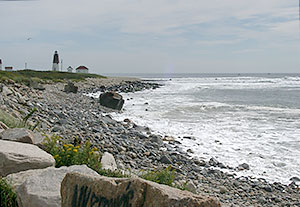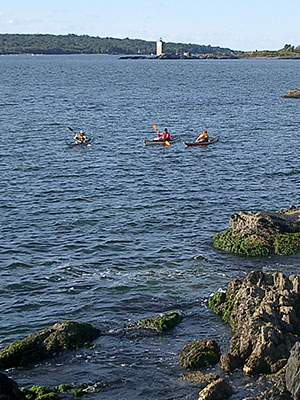Paddling Wider Waters:
Staying out of Trouble on the Bay
Youíve been paddling your kayak on lakes and rivers and now you want to venture onto the wider waters. Narragansett Bay is a beautiful place, but you are right to be concerned about getting into trouble. There are lots of additional things to be aware of and ready for when paddling on salt water. If you are new to paddling Iíd recommend that you first get some experience on lakes and rivers, and very protected parts of the bay, before you venture onto larger waters. Whether you are paddling on salt water or fresh, always wear your life jacket, and always tell someone what route you plan to paddle and when you plan to get back, so that if you donít come back in time they will know where to tell searchers to look for you.
The weather has a much bigger impact on salt water than on all but the largest of fresh water lakes in our area. A southwest wind that might make paddling more difficult on a small lake or river can quickly create large waves on the bay, big enough to flip a kayak and make it very difficult to get back on board. Remember that even if you have learned how to self-rescue in quiet water, it can be very difficult to self-rescue when waves are tossing you around and constantly refilling the kayak with water.

Summer surf at Point Judith.
photo courtesy of John Monroe, National Park Service
Fog also presents more challenges on the bay or ocean than on a lake or river. On a lake or river, if you paddle long enough youíre almost certain to find the shore. On the bay, if you paddle in the wrong direction in the fog you may be setting a course for Africa! So, always carry a compass and know how to use it, and carry the appropriate nautical chart and know how to read it. And, always check the general weather forecast and the marine forecast before heading out on the water. The marine forecast, as well as the current bay water temperature, are available at wunderground.com and other websites.
Tides present another challenge on the bay and ocean. When your kayak is on shore but near the water, remember that the tide may be coming in, and so a kayak that is safely on shore now could be floating away if you leave it for long. Also, in many places on the bay the tidal current can be strong enough to be hard or impossible to paddle against. In addition, if the wind is blowing against the current you can get very short, steep breaking waves.
The bay and ocean warm up more slowly than fresh water lakes and rivers. So, in mid-June, when the air temperature may hit 90 and the water in lakes and rivers may well be in the mid-60ís or even over 70, the bayís waters are often still in the 50ís. At those water temperatures, if you end up in the water you will have only a few minutes before you start to loose the ability to use your muscles, and even once you get out of the water you may by so hypothermic youíll need immediate medical attention to survive. So, consider waiting until July to paddle on the bay. Also, always dress for the water temperature not the air temperatures. If it is at all cool, wear synthetics, not cotton, and bring a raincoat or paddling jacket that will keep you dry, and if the water temperatures is below 60 or the sum of the air and water temperature is less than 120 then wear a wetsuit or a dry suit.

Paddling along the shore of Beavertail State Park on a quite day
photo courtesy of John Monroe, National Park Service
Remember that when you are in a kayak you are nearly invisible to most larger boats. Do what you can to make yourself more visible: wear a bright hat (your highest point), carry a radar reflector in the fog, and still expect that most boats wonít see you. Carry a horn so you can warn boats of your presence. A waterproof VHF radio will allow you to talk to larger boats (and call for help if you get into trouble), but make sure you know the protocols for using a VHF before you use it.
While commercial traffic has been rare on Rhode Islandís fresh water rivers and lakes for many generations, it is still common on our bays and ocean, and larger pleasure craft are also very common on the bay. Any boat larger than a kayak should always be given the right of way. Very large vessels travel up and down the bay daily, going to and from the Ports of Providence, Fall River and Quonset Point and these vessels present special dangers. Even if they could see you in your kayak, these vessels are often powerless to avoid you since they are restricted to narrow channels where the water is deep enough for them, and they commonly take a mile or more to bring to a stop. Big ships also move deceptively fast: they can look far away one moment and before you know it they are right on top of you. So, know where the shipping channels are and stay out of them if at all possible. If you must cross a shipping channel never cross in front of a large ship, even if it appears to be far away.
Staying close to shore can make things safer, but remember that a shore that seems close when floating in your kayak can seem very far away if you are cold and in the water and weighted down with clothing. Also, if the shoreline is rocky and fringed with breaking waves, the shore may well represent another danger, rather than safety.
This list is by no means comprehensive so Iíd encourage you to go paddling with more experienced paddlers, or take classes with one of the outfitters in the area that offers classes. See the outfitters and links pages on ExploreRI.org for more information on local groups that run paddling trips and outfitters that offer classes. And see the Paddle Safely page on ExploreRI for more safety information. And always wear your life jacket!
Narragansett Bay is a one of Rhode Islandís treasures, but to paddle it safely you need to be prepared. Happy (and safe) paddling!
This article was originally published (in a modified form) in the Spring/Summer 2013 edition of Trail Mix, the Newsletter of The Greenways Alliance of Rhode Island. RI Blueways thanks the Greenways Alliance for giving us permission to republish this articles



